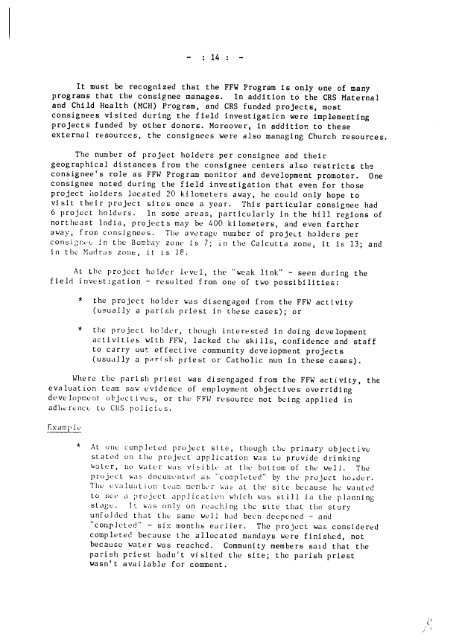(PDF, 101 mb) - USAID
(PDF, 101 mb) - USAID
(PDF, 101 mb) - USAID
You also want an ePaper? Increase the reach of your titles
YUMPU automatically turns print PDFs into web optimized ePapers that Google loves.
- 14: -<br />
It must be recognized that the FFW Program is only one of many<br />
programs that the consignee manages. In addition to the CRS Maternal<br />
and Child Health (MCH) Program, and CRS funded projects, most<br />
consignees visited during the field investigation were implementing<br />
projects funded by other donors. Moreover, in addition to these<br />
external resources, the consignees were also managing Church resources.<br />
The nu<strong>mb</strong>er of project holders per consignee and their<br />
geographical distances from the consignee centers also restricts the<br />
consignee's role as FFW Program monitor and development promoter. One<br />
consignee noted during the field investigation that even for those<br />
project holders located 20 kilometers away, he could only hope to<br />
visit their project sites once a year. This particular consignee had<br />
6 project holders. In some areas, particularly in the hill regions of<br />
northeast India, projects may be 400 kilometers, and even farther<br />
away, from consignees. The average nu<strong>mb</strong>er of project holders per<br />
consignec- in the Bo<strong>mb</strong>ay zone is 7; in the Calcutta zone, it is 13; and<br />
in the Madras zone, it is 18.<br />
At the project holder level, the "weak link" - seen during the<br />
field investigation - resulted from one of two possibilities:<br />
* the project holder was disengaged from the FFW activity<br />
(usually a parish priest in these cases); or<br />
the project holder, though interested in doing development<br />
activities with FFW, lacked the skills, confidence and staff<br />
to carry out effective community development projects<br />
(usually a paris|; priest or Catholic nun in these cases).<br />
Where the parish priest was disengaged from the FFW activity, the<br />
evaluation team saw evidence of employment objectives overriding<br />
development objectives, or the FFW resource not being applied in<br />
adhruncc to CRS policies.<br />
Ex amp1<br />
At one completed project site, though the primary objective<br />
stated on the project application was to provide drinking<br />
water, tic water was vtsibly at the bottom of the well. The<br />
project wa,, documented as "completed" by the project holder.<br />
The evalu;iLion teair me<strong>mb</strong>er was at the site because he wanted<br />
to see a project application which was still in the planning<br />
stage. I 1was only on reaching the site that the story<br />
unfolded that the same well had been deepened - and<br />
"completed" - six months earlier. The project was considered<br />
completed because the allocated mandays were finished, not<br />
because water was reached. Community me<strong>mb</strong>ers said that the<br />
parish priest hadn't visited the site; the parish priest<br />
wasn't available for comment.

















